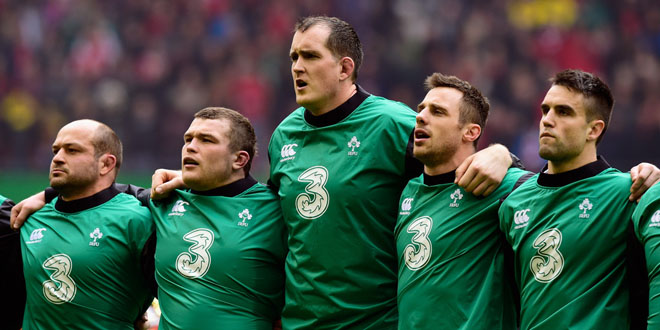Just a week away from the biggest show in the rugby-verse, let’s take a look at some of the interesting numbers for you trivia-minded folk heading into the Rugby World Cup.
BIGGER IS BETTER
There will be some seriously tall timber on display during the tournament. Five players top 205cm (6’9”), and while the actual measurement of his height ranges between 208cm (6’10”) and 211cm (6’11”), there’s no question Devin Toner of Ireland is at the head of the class. Luke Charteris of Wales has been listed as low as 206cm (6’9”) but is likely closer to that 208cm (6’10”) mark, while Scotland’s Richie Gray is there or thereabouts at 207cm (6’9.5”).
Only four teams (Canada, Japan, Romania, Uruguay) do not have at least one player 2 metres in height on their roster, with Romania most unusual considering they have left several second rows of that height at home. The average size of a World Cup lock is 198cm (6’6”) and 116kg (255lbs), but if you’re playing for a Tier 1 nation that jumps up slightly to nearly 201cm (6’7”) and 118kg (260lbs). How about the back row? 190cm (6’3”) and 108kg (238lbs) is your typical loose forward at the highest level these days.
As for pure beef, nobody tips the scales further than tighthead prop Uini Atonio – New Zealand born and of Samoan ancestry but playing for France – who walks around at a massive 142kg (312lbs) while standing 196cm (6’5’). That’s after losing a few kilos during training of course. Giant Wallabies lock Will Skelton, 203cm (6’8”) and 140kg (308lbs), is just behind, while Census Johnston’s call-up to the Manu Samoa puts him in the mix at around 138kg (304lbs).
But wait, what about Opeti Fonua, the giant Tongan no8? He’s been training hard with Leicester in the pre-season and has ‘slimmed’ down to around 135kg (297lbs), while England’s Billy Vunipola, also of Tongan stock, has streamlined down from 138kg (304lbs) to a positively svelt 130kg (286lbs). If you want to be a prop at the World Cup, you’re going to want to be close to the 120kg mark (264lbs) just to be average.
Of course the game played in heaven is one enjoyed by players of all shapes and sizes, and that’s where the scrumhalves come in. Japanese duo Fumiaki Tanaka and Atsushi Hiwasa are both about 166cm (5’5.5”), but are just pipped by Namibia’s Damian Stevens at 165cm (5’5”) and the shortest man in the competition, Vazha Khutsishvili, who is a mere 164cm (5’4.5”).
Khutsishvili is strongly built for a little fellow, however, and is a good 5kg (11lbs) heavier than Stevens, who at 68kg (150lbs) is the only player lighter than Samoan will-o’-the-wisp Vavao Afemai, generally listed at 69kg (152lbs), though he might not even be that. Using him as a standard of measurement, Atonio could be listed as around 2.1 Afemai’s!
EXPERIENCE COUNTS
The most experienced player is obviously the all-time record setter Richie McCaw of New Zealand at an astonishing 142 caps, with teammate Keven Mealamu next up at 126. Some 13 participants have won a century or more of caps for their country, with recalled Mike Phillips the next in line at 99 – if you include his five Lions test appearances – and Sean Lamont awfully close on 97 caps for Scotland.
In the age department there are 12 players who were born before 1980, the oldest being un-retired Springbok legend Victor Matfield, 38 years and 130 days old when the tournament kicks off in a week. Only three of those are not tight forwards, though Tonga’s Hale T-Pole (36 years, 141 days) does spend some time in the second row these days. Italian flanker Mauro Bergamasco (36 years, 140 days) is still a full-time flanker, while the only back on that list is Japan’s Craig Wing, still running around in the midfield at 35 years, 266 days.
Highly likely to become the youngest ever player at a World Cup is Georgian scrumhalf Vaso Lobzhanidze, the only one of ’96 vintage who doesn’t turn 19 years old until October 14. Four others were eligible for u20 action this season, namely Damian Stevens and Louis van der Westhuizen of Namibia, Romanian fullback Sabin Stratila, and US Eagles prop Titi Lamositele.
As for test experience, there are 13 players who have just a solitary cap on their record, but three who are still to make their debut. Romanian scrumhalf Tudorel Bratu and American front rower Joe Taufete’e have played for their country but not in a test, while Josh Strauss only qualifies to play for Scotland through residency on September 19, the day after the tournament kicks off!
Team-wise, the most experienced group is – surprise, surprise – New Zealand! The All Blacks have an incredible 1484 caps between their 31 players, an average of nearly 48 apiece. South Africa at 1297 and Australia with 1263 are second and third, respectively. At the bottom of the barrel is Samoa, who have just 481 international caps on their ledger, and that’s including the seven Pacific Islander test appearance spread between Census Johnston, Tusi Pisi, and Alesana Tuilagi. Not far ahead are ‘minnows’ Namibia (521), Tonga (529+21 PI), and the USA (567).
Inexperienced doesn’t necessarily translate to being young, however, as Tonga are the oldest team at the competition, averaging a hair under 30 years of age, while Samoa are also fairly geriatric at 29.7 years on average. The youngest? Hosts England, who come in full of youthful vigour at just 26.6 years old. Georgia, Uruguay, and Wales are just behind on 26.8.
Look for more numbers on World Cup records in the coming days!
 Americas Rugby News Rugby news from across the Americas!
Americas Rugby News Rugby news from across the Americas!




